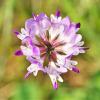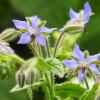Tea Tree (Melaleuca Alternifolia) oil is strongly anti-viral, anti-fungal, anti-bacterial, and anti-parasitic. Tea Tree oil is the second most antiseptic of all known natural substances, second only to thyme oil. It is eight times more effective than commercial phenol and seven times more anti-microbial than lavender oil.
The Australian Aborigine has a long history of Tea Tree used for many medicinal purposes involving the inhalation of the vapors from the raw crushed plant for respiratory infections and applying the raw crushed pulp to both fresh and infected wounds to stimulate rapid healing and new tissue growth.
Thanks to a prolonged antiseptic and antibacterial action, Melaleuca Alternifolia oil is helpful for warts, blisters, ringworm, lice, nits, golden staphylococci infections, cold sores, herpes, thrush, and other conditions. It is intensely healing and soothing to herpes sores and will help prevent infection of the sore. Tea Tree oil safely disinfects and heals infected sores and wounds.
Tea Tree oil is a fantastic local immune stimulant and can help defend the body against skin-borne organisms. The presence of infection in a wound treated with Melaleuca alternifolia oil seems to increase the healing effects of the tea tree on the wound, probably as a direct result of its' immuno-stimulant properties.It regulates and long-term controls sebum secretion. Melaleuca alternifolia oil is a good treatment for acne, ringworm, boils, ulcers, warts, tinea, and athlete's foot. It will also relieve the pain from painful insect bites and stings. Tea Tree oil can be fully effective for certain conditions in concentrations as low as 2.5% dilution.
Active ingredients (or INCI)
Ingredient products
About plant
Tea tree oil is an essential oil derived from the hydrodistillation of leaves from the Melaleuca Alternifolia, a tree specific to New South Wales (Australia). The tree belongs to the family of Myrtaceae. Its popular name comes from the use that the first pioneers accompanying Captain Cook attempted, i.e., to use it as a substitute for tea.
Tea tree oil has been widely used in Australia for decades in the full range of cosmetic products.
Properties
Over the past 30 years, many scientific studies have demonstrated the antiseptic qualities of tea tree oil. More and more researches are in progress to evaluate other valuable properties of this oil.
Over 50 components constitute tea tree oil. The most significant in decreasing order of antiseptic power are the 1-terpinen-4-ol, alpha-terpineol, cineol 1.8, terpinolene, and the alpha-terpinen.
In British and US Pharmacopeas nowadays, tea tree essential oil is described as having a positive action against:
- STAPHYLOCOCUS CURREUS
- ESCHERICHIA COLI
- PSEUDOMONAS AERUGINOSA
- CANDIDA ALBICANS
- ASPERGILLUS NIGER
Uses
An entirely natural essential oil of the most significant interest, it penetrates the skin quickly.
It is used in an extensive range of products :
- antiseptics and veterinary shampoos;
- cosmetics and hygiene products;
- household products (disinfectants and cleaning products)












